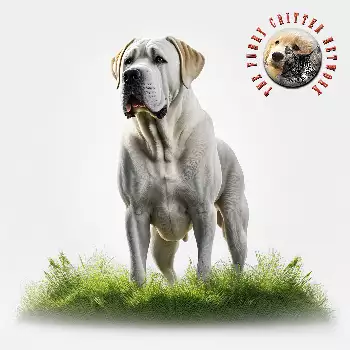The health profile of the Gran Mastin de Borinquen presents a complex picture shaped by both the advantages and disadvantages of their extreme rarity and historical breeding practices. On one hand, the breed has survived for centuries in the challenging tropical environment of Puerto Rico, suggesting inherent hardiness and adaptation to local climate conditions, parasites, and diseases. Their historical breeding by practical-minded rural families focused on functional rather than aesthetic traits, which often resulted in healthier dogs compared to breeds subjected to intensive show breeding programs that sometimes prioritize appearance over health. However, the breed's current near-extinction status creates significant health challenges related to genetic bottlenecks, limited breeding stock, and lack of systematic health monitoring that characterize healthy breed populations.
Like most large and giant breed dogs, the Gran Mastin de Borinquen is susceptible to several orthopedic conditions that can significantly impact quality of life and working ability. Hip dysplasia represents a primary concern, where malformation of the hip joint can lead to pain, lameness, and arthritis that may worsen with age. Given the breed's substantial size and weight, hip problems can be particularly debilitating, limiting mobility and affecting their ability to perform their traditional guardian functions. Elbow dysplasia, another developmental orthopedic condition, can cause front-leg lameness and chronic pain that affects the dog's gait and willingness to exercise. The breed's history of working on varied terrain in Puerto Rico may have provided some natural selection against severe orthopedic problems, but without modern screening programs, the prevalence of these conditions in current populations remains unknown.
Cardiac health concerns are common among large mastiff-type breeds, and the Gran Mastin de Borinquen likely shares this predisposition to various heart conditions. Dilated cardiomyopathy, where the heart muscle becomes weakened and enlarged, can develop gradually and may not show symptoms until the condition is advanced. This condition is particularly concerning in working dogs, as their protective duties may require sudden bursts of activity that can strain a compromised cardiovascular system. Other cardiac conditions such as aortic stenosis or various congenital heart defects may also occur, though the lack of systematic health data makes it difficult to determine the actual prevalence of these problems in the breed.
The tropical environment of Puerto Rico exposes these dogs to various parasitic and infectious diseases that may not affect dogs in other geographic regions. Heartworm disease, transmitted by mosquitoes, poses a constant threat in the Caribbean climate and can be fatal if left untreated. Various tick-borne diseases, intestinal parasites, and fungal conditions endemic to tropical regions may affect the breed's health and require specialized preventive care protocols. Their traditional role as estate guardians, often living partially outdoors, increases exposure to these environmental health risks and requires vigilant preventive healthcare to maintain good health.
Gastric dilatation-volvulus (bloat) represents an emergency condition that commonly affects large, deep-chested breeds like the Gran Mastin de Borinquen. This condition, where the stomach fills with gas and potentially twists on itself, can be rapidly fatal without immediate surgical intervention. The breed's size, chest conformation, and eating habits may predispose them to this condition, making awareness of symptoms and immediate access to emergency veterinary care essential for owners. Preventive measures such as feeding smaller, more frequent meals and limiting exercise immediately after eating can help reduce risk, but the condition can still occur even with proper management.
The breed's extremely small population creates additional health challenges related to genetic diversity and inbreeding. With so few authentic examples remaining, breeding choices are severely limited, potentially leading to concentration of both desirable and undesirable genetic traits. Inbreeding depression can result in reduced fertility, smaller litter sizes, increased puppy mortality, and greater susceptibility to various diseases. The lack of genetic diversity also makes the breed more vulnerable to new diseases or environmental challenges, as there may be insufficient genetic variation to allow adaptation to changing conditions.
Common Health Issues
- Hip Dysplasia - Malformation of hip joints causing pain, lameness, and arthritis
- Elbow Dysplasia - Developmental abnormalities affecting front leg joints
- Dilated Cardiomyopathy - Heart muscle weakness leading to enlarged heart
- Gastric Dilatation-Volvulus (Bloat) - Emergency stomach condition requiring immediate surgery
- Heartworm Disease - Mosquito-transmitted parasitic infection affecting heart and lungs
- Tick-borne Diseases - Various illnesses transmitted by tropical ticks
Recommended Health Testing
- Hip and Elbow Radiographs - Orthopedic screening for dysplasia
- Cardiac Examination - Annual heart evaluation including echocardiography when indicated
- Heartworm Testing - Regular screening for parasitic infection
- Complete Blood Count and Chemistry Panel - Annual wellness screening
- Tick-borne Disease Panel - Testing for regional parasitic diseases
- Genetic Testing - DNA analysis for available hereditary conditions when possible
Preventive healthcare for the Gran Mastin de Borinquen must be adapted to both their specific breed characteristics and the environmental challenges of their geographic origin. Regular veterinary examinations, ideally every six months for adult dogs and more frequently for senior animals, allow for early detection of developing problems. Vaccination protocols should address the specific disease risks present in tropical environments, including diseases that may be uncommon in other regions. Parasite prevention programs must be comprehensive and year-round, addressing heartworm, various tick species, fleas, and intestinal parasites endemic to Caribbean environments. Dental care, often overlooked in large working breeds, requires attention as dental disease can affect overall health and may be particularly problematic for dogs whose protective duties require reliable bite strength and oral health.

